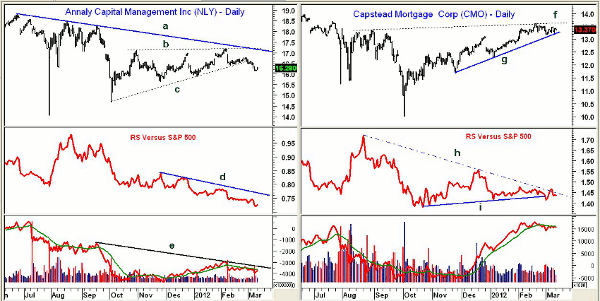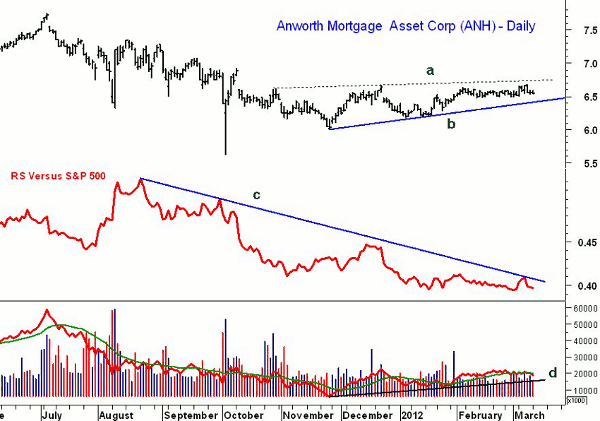High-yielding REITs may seem attractive at first glance, but vulnerable chart patterns, use of leverage, and potential dividend cuts make REITs like these especially dangerous.
Investors in low-yielding investments are likely frustrated by the historic stock market rally, as even a more conservative ETF like the SPDR S&P Dividend ETF (SDY) is up 4.78% so far this year. This ETF invests in the 50 highest-yielding dividend stocks of the S&P 1500 Composite that have also increased their dividends for at least 25 consecutive years.
Some of those searching for yield have been turning to the agency mortgage REITs, which are also being recommended by a number of analysts and columnists. These REITs are exclusively invested in mortgage securities that are insured by federal agencies.
These REITs obtain the high yields by using leverage of five to eight times. Should rates begin to rise, this leverage will magnify any losses. As I noted last week, my intermediate-term momentum analysis suggests that the yields on 30-year Treasury bonds have bottomed.
This suggests that holders of these REITs may be in for further price declines and their charts suggest they are also vulnerable. This would make their current high yields look considerably less attractive.
Chart Analysis: One of the best-known agency-backed REITs is Annaly Capital Management (NLY), which currently yields 14.1%. The technical action in NLY has concerned me since last August (see “High-Yield Bets Bite Back”), and it is now over 6% lower.
- The cut in the dividend from 65 cents in the second quarter of 2011 to 57 cents at the end of 2011 clearly increased the selling pressure
- The daily chart shows that the flag formation (lines b and c) was completed in early March
- Next good support is in the $15.60-$15.90 area
- The flag formation has downside targets in the $14-$14.40 area
- Daily relative performance, or RS analysis, has been forming lower lows over the past four months
- Daily on-balance volume (OBV) also shows lower highs and is now just below its weighted moving average (WMA)
- There is first resistance now at $16.40-$16.80 with the daily downtrend, line a, in the $17.15 area
Capstead Mortgage Corporation (CMO) is a $1.2 billion, Dallas-based REIT that currently yields 12.8%. It made a low last October at $10 and peaked in February at $13.62, line f.
- For the past two weeks, CMO has been sitting on its uptrend, line g. A close below $13.10 will be a sign of weakness
- The RS line tested its downtrend, line h, last week after breaking its support, line i, at the end of February
- This action in the RS Analysis suggests that prices are also vulnerable on the downside
- The daily OBV rallied sharply from the December lows but now appears to be topping out
- A drop below the OBV’s recent lows will be negative and suggest a decline to the support in the $12.40-$12.70 area
NEXT: Red Flags for Another High-Yielding REIT
|pagebreak|Anworth Mortgage Asset Corp. (ANH) has a market cap of $880 million and currently yields 12.8%. ANH has been in a tight trading range since early November, lines a and b. There is trend line support at $6.41, and a drop below the January lows at $6.18 would be more negative.
- The relative performance has continued to make lower highs, line c, and lower lows. This indicates it is likely to stay weaker than the S&P 500
- OBV has traded sideways and shows no signs of accumulation
- A break of OBV support at line d would be more negative
- Initial resistance for ANH is at $6.66 with stronger resistance at $6.73, line a
What It Means: While these three REITs may hold their current price levels for a while, I do expect them to be significantly lower in the coming months. Given the leverage that is used, management skills are a valid concern, and more dividend cuts are likely, in my opinion.
Though I am no expert in analyzing financial statements, when I see that Anworth Mortgage Asset Corp. (ANH) has $8.8 million in cash on hand and a debt of a $7.7 billion, I get even more nervous.
How to Profit: I continue to suggest that investors avoid these REITs, but if you are currently long any of them, do watch the price performance closely and have tight stops in place.
Of course, those who are experienced with options could consider hedging their positions using options. The cost of hedging will need to be compared with the potential income to see if it makes sense, however.




















